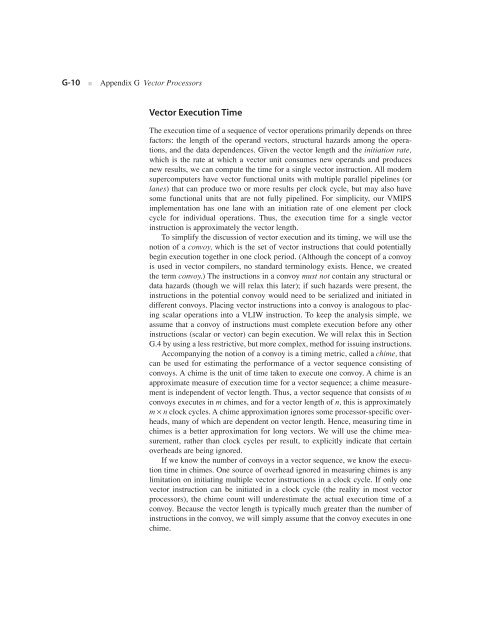Appendix G - Clemson University
Appendix G - Clemson University
Appendix G - Clemson University
Create successful ePaper yourself
Turn your PDF publications into a flip-book with our unique Google optimized e-Paper software.
G-10 ■ <strong>Appendix</strong> G Vector Processors<br />
Vector Execution Time<br />
The execution time of a sequence of vector operations primarily depends on three<br />
factors: the length of the operand vectors, structural hazards among the operations,<br />
and the data dependences. Given the vector length and the initiation rate,<br />
which is the rate at which a vector unit consumes new operands and produces<br />
new results, we can compute the time for a single vector instruction. All modern<br />
supercomputers have vector functional units with multiple parallel pipelines (or<br />
lanes) that can produce two or more results per clock cycle, but may also have<br />
some functional units that are not fully pipelined. For simplicity, our VMIPS<br />
implementation has one lane with an initiation rate of one element per clock<br />
cycle for individual operations. Thus, the execution time for a single vector<br />
instruction is approximately the vector length.<br />
To simplify the discussion of vector execution and its timing, we will use the<br />
notion of a convoy, which is the set of vector instructions that could potentially<br />
begin execution together in one clock period. (Although the concept of a convoy<br />
is used in vector compilers, no standard terminology exists. Hence, we created<br />
the term convoy.) The instructions in a convoy must not contain any structural or<br />
data hazards (though we will relax this later); if such hazards were present, the<br />
instructions in the potential convoy would need to be serialized and initiated in<br />
different convoys. Placing vector instructions into a convoy is analogous to placing<br />
scalar operations into a VLIW instruction. To keep the analysis simple, we<br />
assume that a convoy of instructions must complete execution before any other<br />
instructions (scalar or vector) can begin execution. We will relax this in Section<br />
G.4 by using a less restrictive, but more complex, method for issuing instructions.<br />
Accompanying the notion of a convoy is a timing metric, called a chime, that<br />
can be used for estimating the performance of a vector sequence consisting of<br />
convoys. A chime is the unit of time taken to execute one convoy. A chime is an<br />
approximate measure of execution time for a vector sequence; a chime measurement<br />
is independent of vector length. Thus, a vector sequence that consists of m<br />
convoys executes in m chimes, and for a vector length of n, this is approximately<br />
m × n clock cycles. A chime approximation ignores some processor-specific overheads,<br />
many of which are dependent on vector length. Hence, measuring time in<br />
chimes is a better approximation for long vectors. We will use the chime measurement,<br />
rather than clock cycles per result, to explicitly indicate that certain<br />
overheads are being ignored.<br />
If we know the number of convoys in a vector sequence, we know the execution<br />
time in chimes. One source of overhead ignored in measuring chimes is any<br />
limitation on initiating multiple vector instructions in a clock cycle. If only one<br />
vector instruction can be initiated in a clock cycle (the reality in most vector<br />
processors), the chime count will underestimate the actual execution time of a<br />
convoy. Because the vector length is typically much greater than the number of<br />
instructions in the convoy, we will simply assume that the convoy executes in one<br />
chime.

















